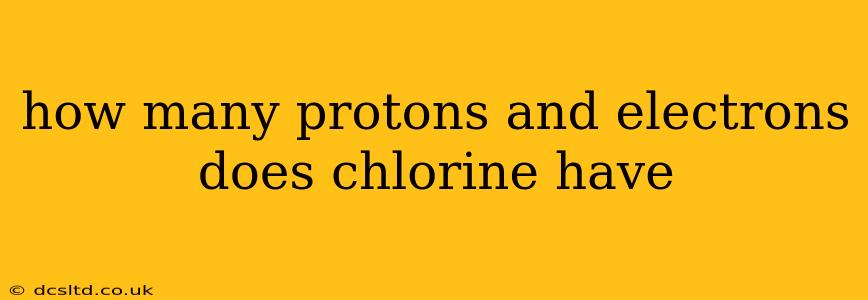Chlorine, a crucial element in many aspects of our lives, from household cleaning to industrial processes, has a unique atomic structure. Understanding its number of protons and electrons is fundamental to grasping its chemical behavior and reactivity. This article will delve into the specifics of chlorine's atomic composition, clarifying any confusion surrounding its proton and electron count.
How Many Protons Does Chlorine Have?
The number of protons an atom possesses defines its element. This is known as the atomic number. Chlorine's atomic number is 17. This means that every chlorine atom has 17 protons in its nucleus. This is non-negotiable; a change in the proton number would transform the atom into a different element entirely.
How Many Electrons Does Chlorine Have?
In a neutral chlorine atom (meaning it has no overall electric charge), the number of electrons is equal to the number of protons. Therefore, a neutral chlorine atom has 17 electrons. These electrons orbit the nucleus in various energy levels or shells.
What About Chlorine Ions?
It's important to note that chlorine atoms readily gain an electron to achieve a stable electron configuration. When a chlorine atom gains an electron, it becomes a negatively charged ion, known as a chloride ion (Cl⁻). In this case, the chloride ion would have 18 electrons (17 original + 1 gained) and still retain its 17 protons. The difference in the number of protons and electrons creates the negative charge.
What are the different isotopes of Chlorine?
While the number of protons remains constant at 17, chlorine exists in nature as a mixture of isotopes. Isotopes are atoms of the same element with the same number of protons but a different number of neutrons. The most common isotopes are Chlorine-35 and Chlorine-37. Both have 17 protons, but Chlorine-35 has 18 neutrons and Chlorine-37 has 20 neutrons. The number of electrons in a neutral atom of either isotope remains 17.
How does the number of protons and electrons affect chlorine's properties?
The 17 electrons, specifically their arrangement in energy levels, determine chlorine's chemical reactivity. Chlorine's high electronegativity (its tendency to attract electrons) and its need to gain one electron to achieve a stable octet in its outermost shell, account for its ability to readily form ionic bonds with many other elements. This reactivity makes chlorine vital in many chemical applications.
Why is understanding the number of protons and electrons important?
Understanding the number of protons and electrons in chlorine is essential for comprehending its chemical behavior and its role in various chemical reactions and compounds. It's a cornerstone of understanding basic chemistry and is fundamental to studying more advanced chemical concepts. This knowledge is critical for various fields such as medicine, materials science, and environmental science.
This detailed explanation should clarify the number of protons and electrons in a chlorine atom, and also highlights the importance of this knowledge in understanding the properties and behavior of this vital element.
